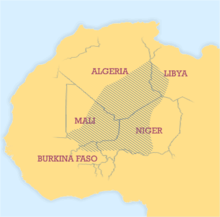Azawad
This article needs additional citations for verification. (February 2012) |


Azawad or Northern Mali, refers to the most remote area of Mali, and also takes in parts of Niger, Mauritania and a small part of the south of Algeria. It comprises the Timbuktu region, Kidal, Gao, and a small part of the Mopti region.
A insurgency is currently ongoing in this territory by MNLA.
Etymology
The word "Azawad" is presumed to be of Tuareg origin.
History
pre-French rule
This section needs expansion. You can help by adding to it. (February 2012) |
Under French rule
Most of the Azawad was inhabited by Tuaregs. After failing to colonise the Azawad via Algeria, the French used Marines to conquer the area from the Niger river region.
Under Malian rule
The area is also notorious for banditry and drug smuggling.[1]
The area is believed to contain a great deal of potential mineral wealth, including petroleum and uranium[2].
A independence fight is currently ongoing in Azawad. See MNLA Many insurgencies have been recorded in the area since 1963. See Tuareg rebellions
Geography
Climate
The local climate is desert or semi-desert, i.e. very arid.
Administrative divisions

It includes Gao, Timbuktu and Kidal
Demographics
Ethnic Groups



The area was traditionally inhabited by Tuaregs, Moors, Songhay and Peuls.
Kidal, Gao, and Timbuktu also have a good amount of Bambara, who settled there mainly after the 1960s.
Languages
Tamashek, Arabic, Fulfule (peul) and Songhay are the most important languages in Azawad. Bambara is spoken by the people of southern Malian descent living in the cities.
External Links
- The Massacres at Tchin Tarabaden: 10 years later!. This press release (7 May 2000), while polemical, is useful for a pro-Tuareg view of the conflicts in Mali and Niger.
- Gao: assassinat de quatre arabes Kounta: l'Etat tente de faire prévaloir la justice sur la vengeance in l'Essor n°14873 January 8, 2003.
- Nord-Mali: les Kounta désavouent Fagaga. Le Républicain, 14 March 2006.
